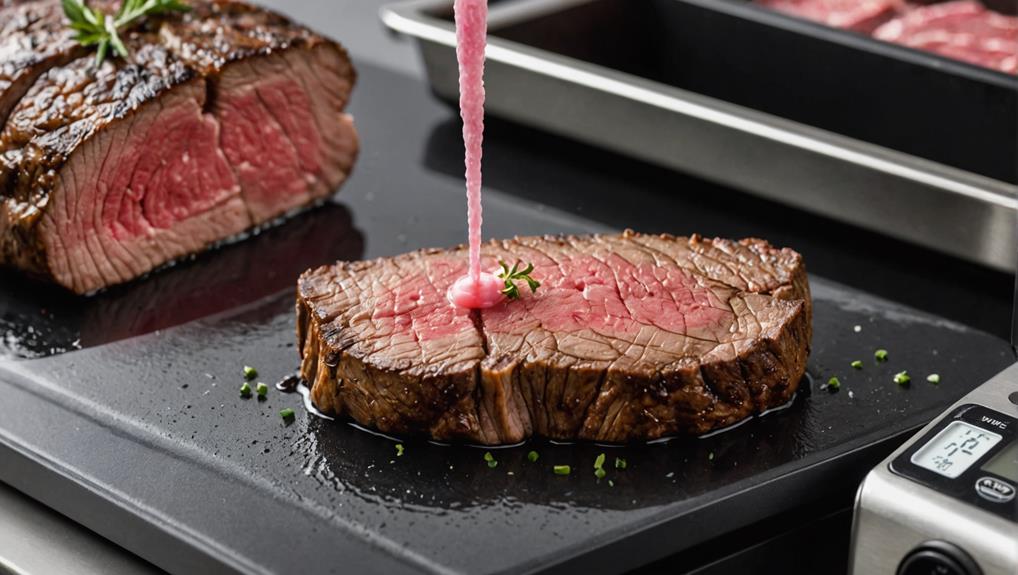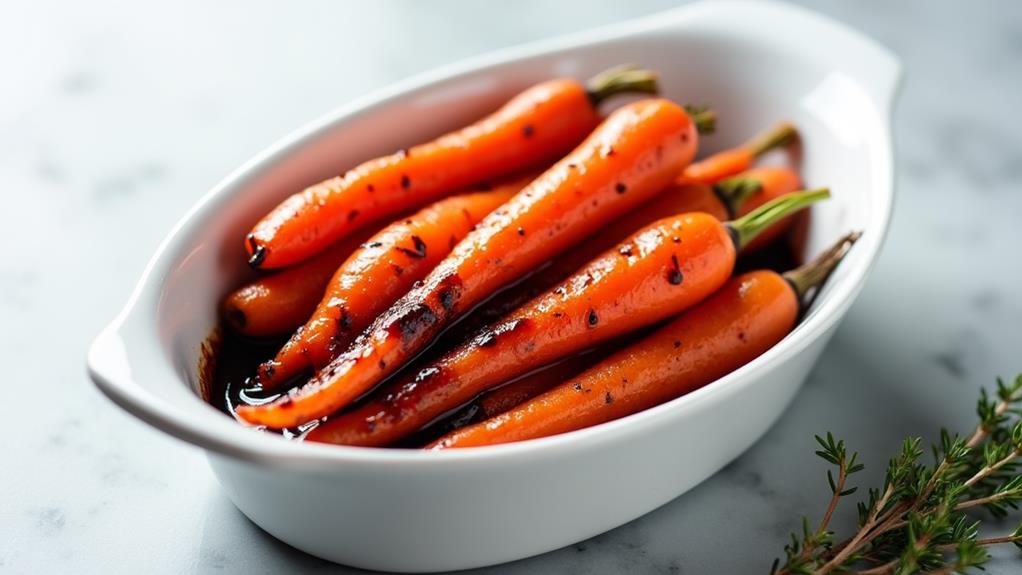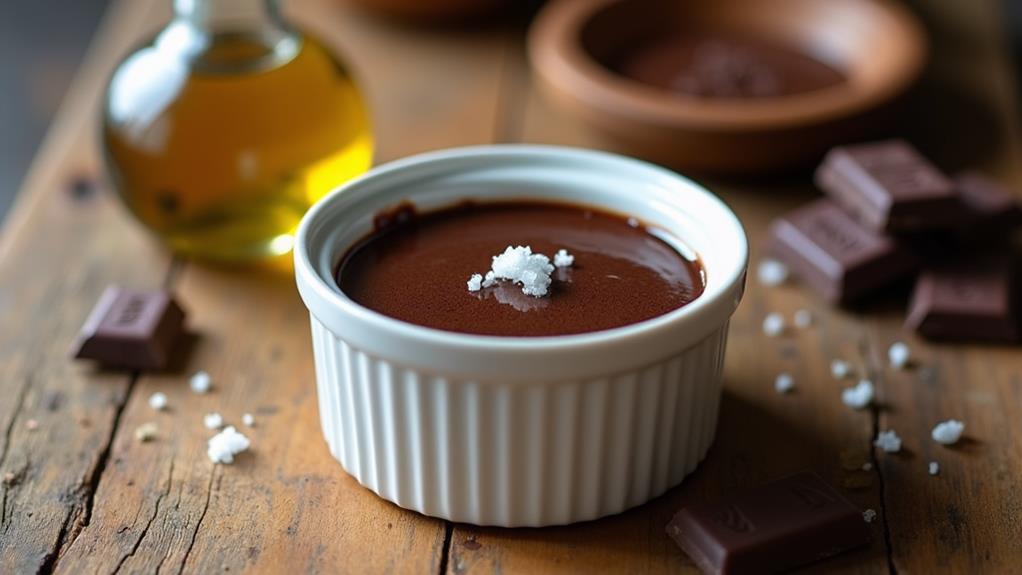To master sous vide cooking, you'll need to avoid key pitfalls. Cook above 130°F to prevent bacterial growth, and ensure your equipment maintains accurate temperatures. Vacuum seal bags properly to eliminate air pockets, and keep your water bath well-maintained. Don't neglect equipment care or proper food storage practices. Select high-quality ingredients for the best results, and handle delicate foods with care. Avoid overcrowding your water bath, which can lead to uneven cooking. By paying attention to these details, you'll significantly improve your sous vide outcomes. Understanding these nuances will elevate your culinary skills to new heights.
Cooking in the Danger Zone
When you're diving into sous vide cooking, understanding the "danger zone" is crucial for food safety. This zone, spanning temperatures between 40°F and 140°F, is where bacteria thrive, potentially compromising your culinary creations.
To sidestep this risk, always cook above 130°F for extended periods. Maintain strict temperature control by preheating your immersion circulator to the desired cooking temperature before adding food. This prevents your ingredients from lingering in the danger zone during the initial cooking phase.
Sous vide cooking times and temperatures are critical factors in ensuring food safety. Follow specific guidelines for different food types to avoid unsafe conditions.
For instance, cooking below 127°F for more than 3-4 hours can lead to bacterial growth. By adhering to proper cooking temperatures and times, you'll create dishes that aren't only delicious but also safe to consume.
Inaccurate Temperature Settings
To achieve sous vide perfection, accurate temperature settings are non-negotiable. As an innovative cooking method, sous vide relies on precise temperature control to deliver exceptional results. When you're dealing with inaccurate temperature settings, you're risking more than just a disappointing meal; you're potentially exposing yourself to foodborne illnesses.
To safeguard your culinary creations, invest in a reliable sous vide precision cooker. These devices maintain temperature-controlled water within a 0.1°F accuracy range, ensuring even cooking throughout your food.
Remember, cooking times and temperatures are critical. For instance, poultry requires a minimum of 165°F (73.9°C) for safety, while beef can be cooked at lower temperatures for tenderness.
Don't forget to regularly calibrate your equipment to avoid discrepancies in temperature readings. Before you start cooking, use a thermometer to verify the water temperature. This simple step can prevent the pitfalls of inaccurate settings and guarantee consistent results.
Inadequate Vacuum Sealing

Why is vacuum sealing crucial for sous vide cooking? Inadequate vacuum sealing can seriously compromise your culinary creations. When air pockets remain in vacuum-sealed bags, they disrupt heat circulation, leading to uneven cooking and potential food safety risks.
You'll want to ensure a tight seal, free from any holes or leaks, to prevent water ingress that could contaminate your food and alter its flavor profile. To master this technique, always double-check your seals before submerging the bags.
Avoid overfilling, as this can hinder effective air removal and proper conformity to the food's shape. Remember, even small openings can drastically affect the cooking process, resulting in loss of flavor and moisture.
Invest in high-quality, food-safe vacuum bags specifically designed for sous vide cooking. These bags prevent harmful chemicals from leaching into your food and maintain the integrity of your culinary masterpiece.
Overlooking Water Bath Maintenance
Many sous vide enthusiasts overlook the critical aspect of water bath maintenance, potentially compromising their culinary efforts. To ensure consistent temperature throughout your cooking process, you'll need to pay close attention to water level and evaporation.
Regularly check and maintain water levels, as evaporation can significantly reduce volume over time, especially during long cooks. Use a lid or cover to minimize water loss and maintain temperature stability. It's crucial to monitor the temperature with an accurate thermometer, as fluctuations can lead to uneven cooking and food safety risks.
Don't forget to clean the sous vide container and accessories after each use to prevent cross-contamination and maintain optimal performance.
Avoid overcrowding the water bath; ensure there's enough space for water to circulate freely around each vacuum-sealed bag. This circulation is essential for even cooking and achieving the desired results.
By implementing these maintenance practices, you'll enhance the precision and reliability of your sous vide cooking, elevating your culinary creations to new heights.
Neglecting Equipment Care
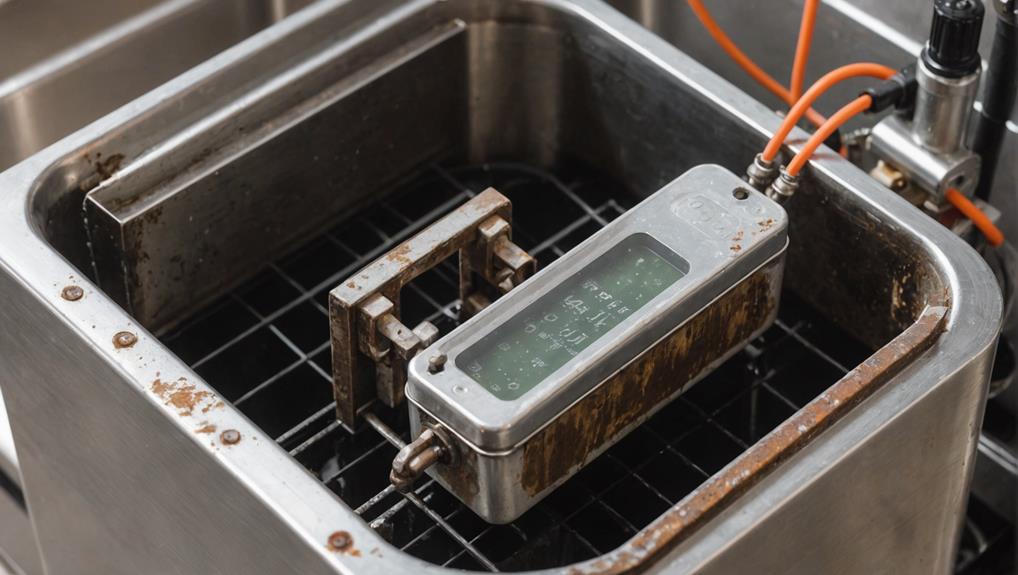
After mastering the art of water bath maintenance, it's crucial to turn your attention to equipment care. Your sous vide machine, vacuum sealer, and other essential tools require regular upkeep to ensure optimal performance and food safety.
Start by cleaning your precision cooker and vacuum sealer after each use, removing any food particles or residue that could harbor bacteria. Don't forget to inspect your water bath container for signs of wear or damage, as leaks can compromise cooking temperatures and safety.
Calibration is key to maintaining accuracy in your sous vide machine. Periodically check and adjust the temperature settings to guarantee precise readings, as even small deviations can result in uneven cooking.
Pay special attention to the immersion circulator's heating element, keeping it free from debris and mineral buildup that could affect its efficiency. While regular plastic bags might seem tempting, invest in proper vacuum sealing equipment for best results.
Skipping the Searing Step
Now that you've mastered equipment care, let's address a common mistake that can undermine your sous vide efforts: skipping the searing step. This crucial final touch transforms your perfectly cooked protein into a visually stunning and flavorful masterpiece.
Searing creates a delectable crust through the Maillard reaction, enhancing both taste and appearance.
To achieve the perfect crust, remember these key points:
- Aim for 45-90 seconds of searing per side
- Use high heat methods like cast iron skillets or torches
- Allow the meat to rest after searing for optimal juiciness
Failing to sear your sous vide creation can result in a pale, uninspiring dish that lacks the golden-brown finish associated with culinary excellence.
By incorporating this step, you'll elevate your sous vide cooking to new heights, impressing even the most discerning palates.
Embrace innovation in your kitchen by mastering the art of searing. With practice, you'll consistently produce restaurant-quality meals that boast both precision-cooked interiors and irresistibly crispy exteriors.
Improper Food Storage Practices
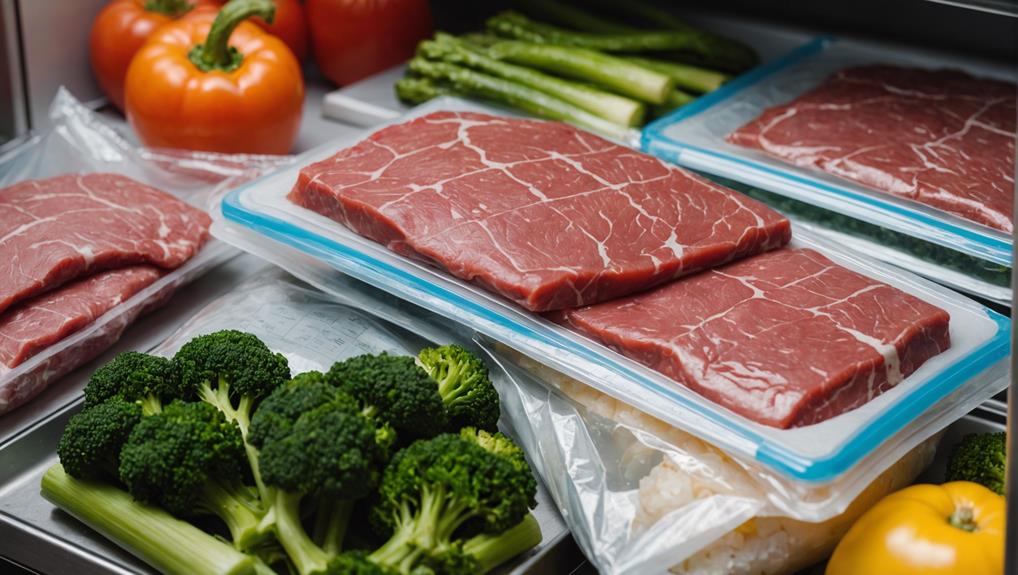
Food safety is paramount in sous vide cooking, and improper storage practices can quickly undo all your hard work. To maintain the quality and safety of your sous vide creations, you'll need to follow some essential guidelines.
First, always refrigerate your cooked items within two hours of preparation to prevent bacterial growth. This crucial step ensures that harmful microorganisms don't have a chance to multiply.
When storing your sous vide dishes, vacuum-seal cooked items before placing them in the refrigerator. This process minimizes air exposure, preserving flavor and extending shelf life.
Don't forget to label your bags with the cooking date and contents, allowing you to track freshness easily. Properly stored sous vide food typically remains safe for 2-3 days in the fridge.
For longer-term storage, freeze vacuum-sealed sous vide items. This method can maintain quality for several months without significant texture or flavor loss.
When you're ready to enjoy your frozen sous vide meal, avoid reheating it directly from the freezer. Instead, thaw it overnight in the refrigerator before reheating to ensure even warming and optimal safety.
Ignoring Ingredient Quality
When it comes to sous vide cooking, you can't afford to overlook the quality of your ingredients.
High-quality meats and produce will enhance your dishes significantly, while cheaper cuts won't improve much even with perfect technique.
It's worth investing in premium ingredients, as they'll absorb flavors better during the sous vide process and result in a more enjoyable final product.
Quality Impacts Flavor Significantly
Flavor is king in sous vide cooking, and the quality of your equipment and technique can make or break your culinary creations. However, even the most advanced sous vide setup can't compensate for inferior ingredients. Quality impacts flavor significantly, and investing in high-quality cuts is essential for achieving restaurant-quality results at home.
The infusion of flavors during the cooking process is more pronounced with premium ingredients, allowing you to experience the full potential of this innovative technique. Additionally, using seasonal ingredients, much like the way butternut squash is featured in Butternut squash risotto, can enhance both taste and presentation, making your dishes stand out even more.
To elevate your sous vide game, consider these key points:
- Choose high-quality meats for superior flavor and texture
- Experiment with cheaper cuts like chuck or brisket for tender, flavorful results
- Opt for garlic powder or roasted garlic instead of raw garlic to avoid undesirable flavors
Remember that sous vide cooking can't enhance poor ingredients. By selecting premium meats and seasonings, you'll unlock the full potential of this cooking technique.
The taste difference between high-quality and low-quality ingredients is noticeable, especially when sous vide's precision allows natural flavors to shine. Embrace this method's ability to transform both premium cuts and tougher meats into extraordinary dishes, and you'll consistently achieve restaurant-worthy results in your own kitchen.
Cheap Cuts Enhance Poorly
Contrary to popular belief, cheap cuts don't automatically enhance well in sous vide cooking. While this method can transform inexpensive meats, it's crucial to understand that the quality of your ingredients significantly impacts the final result. You can't rely on sous vide to compensate for poor-quality meat.
To master sous vide cooking, invest in high-quality meats. These cuts retain superior flavor and texture during the low-and-slow process, enhancing the overall culinary experience.
While sous vide can improve the flavor profile of cheaper cuts like chuck or brisket, the initial quality of the meat remains a key factor in your dish's success.
Avoid using tough meats or those with excessive connective tissue without proper preparation. Even with sous vide, these may result in undesirable textures. Instead, opt for well-sourced cuts with good fat content to maximize flavor and tenderness.
Remember, sous vide isn't a magic solution for subpar ingredients. By choosing quality meats and understanding their characteristics, you'll elevate your sous vide game and consistently create tender meals that impress.
Don't compromise on ingredients if you want to truly innovate in your kitchen.
Invest in Premium Ingredients
Ingredient quality is the cornerstone of exceptional sous vide cooking. When you invest in premium ingredients, particularly high-quality cuts of meat, you're setting the stage for a superior culinary experience.
Sous vide cooking enhances flavors and textures, but it can't transform inferior ingredients into gourmet dishes. To master this innovative cooking method, prioritize ingredient selection and avoid the pitfall of using low-grade products.
Here's why investing in quality ingredients is crucial:
- Improved taste profiles: Premium meats and vegetables allow for more pronounced flavors.
- Better texture: High-quality cuts become tender and flavorful when cooked properly.
- Enhanced overall experience: Superior products inherently yield better results.
Mishandling Delicate Foods

When it comes to sous vide cooking, delicate foods require special attention. Mishandling these items can lead to disappointing results, so it's crucial to understand the nuances of preparing fish, eggs, and other delicate ingredients.
To ensure success, keep your cooking temperatures below 140°F (60°C) for extended periods, as higher heat can degrade texture and cause moisture loss. When sealing delicate foods, opt for gentle vacuum techniques or use the water displacement method with ziplock bags to prevent crushing.
Closely monitor cooking times, as delicate foods typically need shorter durations. For instance, fish fillets often require just 30-45 minutes for optimal texture and flavor. Be cautious with seasoning, as strong spices or excessive salt can overpower delicate flavors. Instead, use subtle seasonings and consider adding more after cooking to enhance taste.
Proper support in the water bath is essential to prevent floating or collisions that could lead to uneven cooking or breakage.
Overcrowding the Water Bath
When using sous vide cooking, you'll want to ensure proper circulation in your water bath for even cooking.
Spacing your food items correctly is crucial, as overcrowding can lead to uneven heat distribution and inconsistent results. By giving each bag enough room, you're allowing the water to circulate freely, maintaining precise temperature control and guaranteeing that your dishes come out perfectly cooked every time.
Proper Circulation Matters
To achieve perfect results with sous vide cooking, you'll need to pay close attention to proper water circulation. Ensuring optimal immersion and consistent temperature distribution throughout the water bath is crucial for food safety and even cooking.
When you overcrowd the bath, you're creating thermal barriers that can lead to undercooked areas and potential safety risks.
To maintain proper circulation during the cooking process, follow these key guidelines:
- Place items in a single layer, allowing water to flow freely around each bag.
- Limit the number of bags to prevent overcrowding and ensure effective cooking.
- Keep bags separated, avoiding contact that could impede heat circulation.
Spacing for Even Cooking
Proper water circulation sets the stage for even cooking, but spacing your sous vide bags correctly is equally important. To achieve optimal results, arrange your vacuum-sealed bags in a single layer, allowing water to flow freely around each one. This spacing for even cooking ensures uniform temperature distribution throughout your dishes.
When cooking multiple items, leave ample space between bags to promote proper water circulation. Avoid stacking bags on top of each other, as this can lead to increased cooking times and potentially prevent parts of your food from reaching the desired temperature.
Remember, overcrowding the water bath can impede heat circulation, resulting in uneven cooking and inconsistent outcomes.
As you prepare your sous vide setup, consider the importance of monitoring water levels regularly. Overcrowding can lead to increased evaporation, which may affect cooking performance and safety.
Frequently Asked Questions
What Is the Downside of Sous Vide?
You'll face challenges with sous vide: mastering temperature control, ensuring food safety, and perfecting vacuum sealing. Long cooking times can be inconvenient, and equipment costs are high. However, the flavor enhancement you'll achieve is unparalleled in innovative cooking.
What Is the Warning About Sous Vide?
Prioritize sous vide safety, optimize temperature control, and perfect cooking times. You'll enhance food quality through precise vacuum sealing. Don't overlook equipment maintenance. Master these elements, and you'll revolutionize your culinary craft, elevating your sous vide experience to new heights.
Do Professional Chefs Use Sous Vide?
Yes, you'll find pro chefs embracing sous vide benefits. They're leveraging sous vide techniques for precise temperature control and innovative sous vide recipes. With cutting-edge sous vide equipment, they're achieving unparalleled precision in their culinary creations, revolutionizing kitchen operations.
What Not to Do With a Sous Vide?
Don't compromise your sous vide safety by using unsafe bags or cooking below 130°F. Avoid overcrowding, ensure proper sealing, and don't overcook. Follow reliable sous vide recipes and timing guidelines to maximize the benefits of this innovative cooking method.
Final Thoughts
By avoiding these common sous vide pitfalls, you'll elevate your culinary skills and consistently achieve restaurant-quality results. Remember, precision is key: studies show that even a 1°F difference can significantly impact texture and flavor. Always calibrate your equipment, maintain proper sealing techniques, and prioritize food safety. With practice and attention to detail, you'll master this cooking method, unlocking a world of perfectly cooked meals that'll impress both family and guests. Embrace the science and art of sous vide for culinary excellence.

